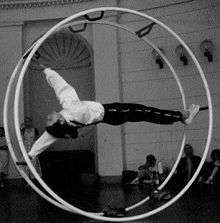Wheel gymnastics


Wheel gymnastics (German: Rhönradturnen) is a form of gymnastics that originated in Germany.
Wheel gymnasts do exercises in a large wheel known as the Rhönrad, gymnastics wheel, gym wheel, or German wheel, in the beginning also known as ayro wheel, aero wheel, and Rhon rod.
There are three core categories of exercise: straight line, spiral, and vault.
History
The wheel was invented in 1925 by Otto Feick in Schönau an der Brend. The grandson of a blacksmith, Feick was inspired by the memory of an event from his childhood in Reichenbach, when he had tied sticks between two cartwheel bands that his grandfather had made and rolled down a hill.[1]
He filed for a patent as "wheel-gymnastic and sports equipment". He had invented the wheel in Ludwigshafen am Rhein ca. 1920-1922, on the grounds of the VSK Germania, a sports club, of which he was the founding chairman. The patent was issued on 8 November 1925; the name "Rhönrad" has been registered and protected since 1926 ("Rhön" is the name of the mountain region where the wheel was invented).
In 1936, this sport was shown at the Olympic Games in Berlin, but was not presented as an Olympic discipline.
The focus of wheel gymnastics remains largely in Germany.
See also
References
- ↑ Jaedicke, Thomas (8 November 2015). "Patent für zwei Reifen und sechs Sprossen" [Patent For Two Hoops and Six Cross-bars]. Deutschlandfunk (in German). Retrieved 1 February 2016.